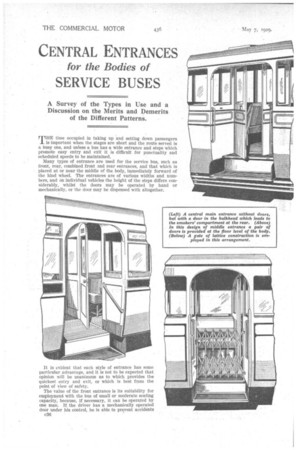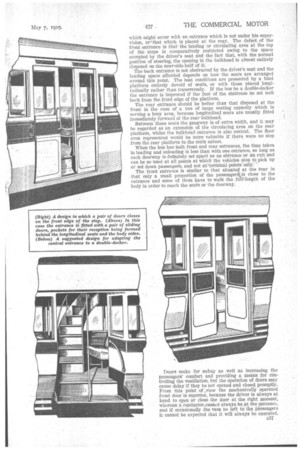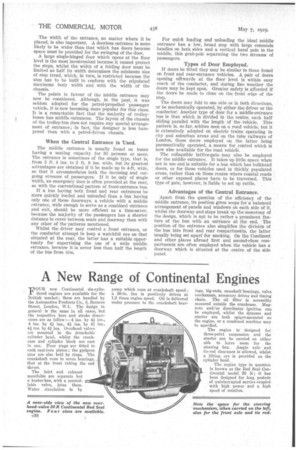CENTRAL ENTRANCES
Page 68

Page 69

Page 70

If you've noticed an error in this article please click here to report it so we can fix it.
for the Bodies of
SERVICE BUSES
A Survey of the Types in Use and a Discussion on the Merits and Demerits of the Different Patterns.
MITE time occupied in taking up and setting down passengers 1 is important when the stages are short and the route served is a busy one, and unless a bus has a wide entrance and steps which promote easy entry and exit it is difficult for punctuality and • scheduled speeds to be maintained.
Many types of entrance are used for the service bus, such as front, rear, combined front and rear entrances, and that which is placed at or near the middle of the body, immediately forward of the hind wheel. The entrances are of various widths and numbers, and on individual vehicles the height of the steps differs considerably, whilst the doors may be operated by hand or mechanically, or the door may be dispensed with altogether.
It is evident that each style of entrance has some particular advantage, and it is not to be expected that opinion will be unanimous as to which provides the quickest entry and exit, or which is best from the point of view of safety.
The value of the front entrance is its suitability for employment with the bus of small or moderate seating capacity, because, if necessary, it can be operated by one man. If the driver has a mechanically operated door under his control, he is able to prevent accidents e36 which might occur with an entrance which is not under his supervision, orfthat which is placed at the rear. The defect. of the front entrance is that' the landing or circulating area at the top of the steps is comparatively restrictedowing to the space occupied by the driver's seat and the fact that, with the normal position of steering, the opening in the bulkhead is almost entirely disposed on the near-side half of it.
The back entrance is not obstructed by the driver's seat and the landing space afforded depends on how the seats are arranged around this point. The best conditionS are presented by a hind platform entirely devoid of -seats, or with those placed longitudinally rather than transversely. If the bus be a double-decker the entrance is improved if the foot of the staircase be set well back from the front edge of the platform. . . The rear entrance should be better than that disposed at the front in the case of a bus of large seating capacity which is serving a busy area, because longitudinal seats are usually fitted immediately forward of the rear bulkhead.
Between these seats the gangway is of extra width, and it may be regarded as an extension of the circulating area on the rear platform, whilst the bulkhead entrance is also central. The floor area represented would be more valuable if there. were no step from the rear platform to the Main saloon.
When the bus has both front and rear entrances, the time taken in loading and unloading is less than with one, entrance. so long as each doorway is definitely set apart as an efitrance or an exit and can be so used at all points at Which the vehicles stop to pick up or set down passengers, and not at-tern-Anil points only.. ' • The front entrance is similar to that situated at the kear in that only a small proportion of the passengerstis close to the entrance and some of them have to walk the fuThiength of the body in order to reach the seats or the doorway.
Doors make for safety as well as increasing the passengers' comfort and providing a means for controlling the ventilation, but the operation of doors may cause delay if they be not opened and closed promptly. From this point of ,view the mechanically operated front door is superior, because the driver is always at hand to open or close the door at the right moment, whereas a conduCtor.cannot always be ,at the entrance, and if occasionally the task be left to the iiassengers it cannot be expected that it will always be executed. The width of the entrance, no matter where it be placed, is also important. A doorless entrance is more likely to be wider than that which has doors because space must be provided for the swinging of the door.
A large single-hinged door which opens at the floor level is the most inconvenient because it cannot protect the steps, whilst the width of a folding door must be limited as half its width determines the minimum size of step tread, which, in turn, is restricted because the step has to be built to conform with the stipulated Maximum body width and with the width of the chassis.
The points in favour of the middle entrance may now be considered. Although, in the past, it was seldom adopted for the petrol-propelled passenger vehicle, it is BOW becoming more popular for this class. It is a remarkable fact that the majority of trolleybuses has middle entrances. The layout of the chassis of the trolley-bus does not require any special arrangement of entrance; in fact, the designer is less hampered than with a petrol-driven chassis.
When the Central Entrance is 'Used.
The middle entrance is usually found on buses having a seating capacity for 30 persons or more. The entrance is sometimes of the single type, that is, • from 2 ft. 4 ins. to 2 ft. 8 ins, wide, but its greatest • advantages are obtained if it be made up to 4-ft. wide, so that it accommodates both the incoming and outgoing streams of passengers. If it be only of single width, an emergency door is often provided at the rear, as with the conventional pattern of front-entrance bus.
If a bus having both front and rear entrances be more quickly loaded and unloaded than a bus having only one of these doorways, a vehicle with a middle entrance, wide enough to serve as a combined entrance and exit, should be more efficient as a time-saver, because the majority of the passengers has a shorter distance to cover between seats and doorway than with any other of the patterns mentioned.
Whilst the driver may control a front entrance, or the conductor attempt to keep a watchful eye on that situated at the rear, the latter has a suitable opportunity for supervising the use of a wide middle entrance, because it is never less than half the length of the bus from him.
For quick loading and unloading the ideal middle , entrance has a low, broad step with large commode handles on both sides and a vertical hand pole in the middle, this grab-pole separating the two streams of passengers.
Types of Door Employed.
If doors be fitted they may be similar to those found on front and rear-entrance vehicles. A pair of doors opening otltwards at the floor level is within easy reach of the conductor, and during fine weather the doors may be kept open. Greater safety is afforded if the doors be made to close on the front edge of the step.
The doors may fold to one side or in both directions, or be mechanically operated, by either the driver or the conductor. Another type of door for a middle-entrance bus is that which is divided in the centre. each half sliding parallel with the length of the vehicle. This pattern is, so far, seldom seen on a rood vehicle, but it is extensively adopted on electric trains operating in city and suburban areas and on the tube railways of London, those doors employed on the latter being pneumatically operated, a means for control which is DOW also available for the road vehicle.
The collapsible lattice-gate may also be employed for the middle entrance. It takes up little space when not in use and is suitable for a bus which has bulkhead doors, or for those vehicles used in thickly populated areas, rather than on those routes where coastal roads or other exposed places have to be traversed. This type of gate, however, is liable to set up rattle.
Advantages of the Central Entrance.
Apart from the question of the efficiency of the middle entrance, its position gives scope for a balanced arrangement of panels and windows on each side of it, whilst the doorway and steps break up the monotony of the design, which is apt to be rather a prominent feature of the bus with an entrance at the end. The position of the entrance also simplifies the division of the bus into front and rear compartments, the latter usually being set aparf for smoking. On the Continent and other places abroad first and second-class compartments are often employed when the vehicle has a doorway which is situated at the centre of the side panel.






























































































































